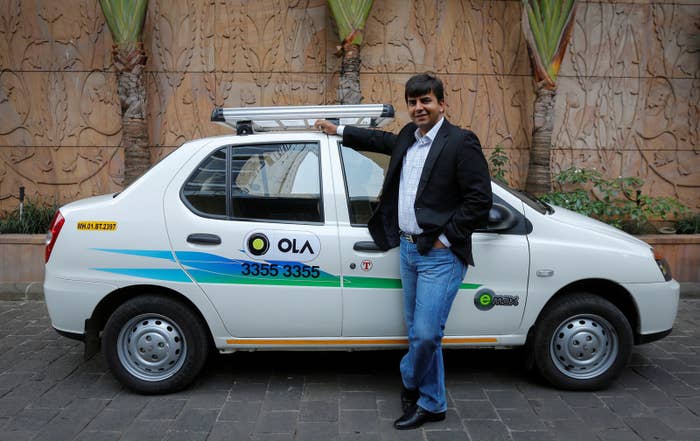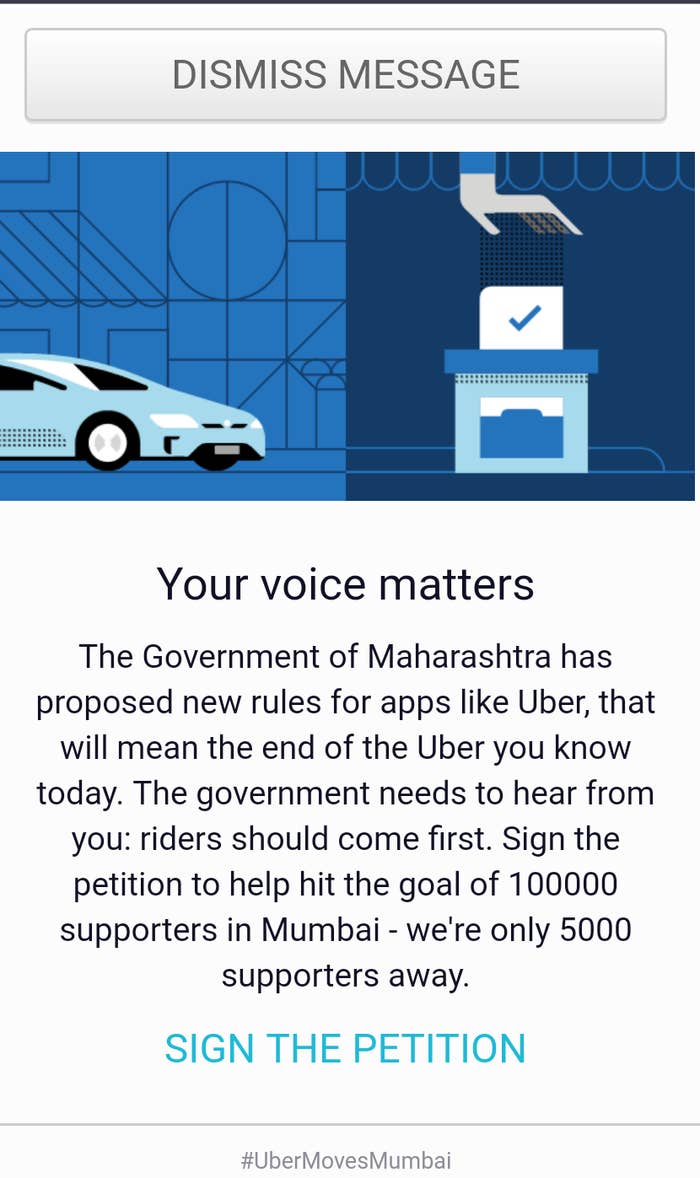
For the last few weeks, anytime people launched the Uber app on their smartphones in Mumbai — India’s financial capital located in the western state of Maharashtra and one of Uber’s most important markets in the world — they were blasted with a full-screen notification.
It urged them to sign a petition to protest against new rules that the government of Maharashtra had proposed last month for ride-hailing apps like Uber. If passed, read Uber’s warning darkly, these new rules would “mean the end of the Uber you know today.” In contrast, Uber's homegrown Indian rival Ola, which counts Mumbai among its top three markets in India, didn’t seem to do much besides send suggestions about the proposed rules to the government.

The rules, prescribed in a soporific 14-page draft, seek to regulate taxi apps like Uber and its homegrown Indian rival, Ola, to placate local taxi drivers in Mumbai who have seen business nosedive ever since the two competing companies entered the the city. It’s a story that has played out hundreds of times around the world ever since Uber, valued at $68 billion , charged into 73 countries in just a few years.
The Maharashtra government’s new rules, however, threaten to fundamentally change how ride-hailing apps work in Mumbai. They ban surge-pricing in favor of a government-mandated fare cap, make it mandatory for thousands of drivers to buy cars with more expensive, higher-capacity engines, and, finally, require drivers to pay the government up to Rs. 2.61 lakh (about $3,000) for a permit before they can sign up to drive with an aggregator, depending on what kind of vehicle they own. The companies themselves will also need to pay Rs. 50 lakh (about $75,000) for every 1,000 cars registered on their platforms.
What was just as interesting as the proposed rules, however, was how the two companies reacted to them. Both companies want the same thing: to coax local and federal authorities to step into a brave new world and revise India’s archaic transportation laws. But while Uber went all out and asked its riders to rally around its cause, Ola barely flinched.
“Look, honestly, we don’t follow a global template like the one they [Uber] have, where if there’s something that’s not favorable to you, you create a public petition,” an Ola employee who wished to remain anonymous told BuzzFeed News.
Uber, of course, is no stranger to hostile policies or less-than-friendly governments. The company has plenty of experience muscling its way into even the toughest markets by playing fast and loose with the rules, then relying on its customers to put political pressure on those who would seek to regulate it out. While this strategy fails on occasion, as it did in Austin Texas, it’s worked in a number of places in the United States, including Las Vegas, where it faced exceptionally strong opposition both from the local governments and cab companies. And its in-app petition, like the one it just showed users in Mumbai, is a well-worn template it uses globally each time it needs to rally public support (Support Uber London! Keep Uber in PA! Keep Chicago Uber!).
“We think the proposed rules not only create a barrier for entry for our driver partners to get on to our platform, but they also make our service less reliable for consumers,” Shailesh Sawlani, Uber’s General Manager in Mumbai who recently appealed to customers to support the company on Uber’s India blog, told BuzzFeed News.
Uber can afford to cry foul, whereas Ola needs to be a lot more cautious.
In the weeks leading up to the Maharashtra government’s November 5 deadline for sending feedback about the new rules, Uber sent a letter to the state’s Chief Minister (India’s Governor equivalent) Devendra Fadnavis. The company wrote that while it agreed that existing taxi drivers were feeling the pressure from ride-hailing services, “the answer is to level the playing field by reducing today’s burdensome regulations — not to introduce rules that will be bad for riders, drivers and Maharashtra.” Uber’s India head, Amit Jain, also made an impassioned pitch for deregulating India’s app-based transport industry at a panel discussion. In the end, more than 100,000 people had signed Uber’s petition.
Meanwhile, Ola didn’t ask users in Mumbai to sign a petition each time they launched its app, nor did the company say anything to the press besides issuing a statement on November 5 summing up the problems it had with the government’s proposed rules — including the ban on surge-pricing, the choice of car, and the exorbitant permits — which were the same complaints that Uber had.
“We think that besides the few things that we have issues with, the government’s proposed policy is actually forward-looking and inclusive,” Pranay Jivrajka, Ola’s Chief Operating Officer, told BuzzFeed News. “The rules the government has proposed are just a draft, which means that they are willing to listen to you and understand you, so we think that working with them closely is the simplest way to get what we want... At some point, we are confident that the government will come up with a solution that’s fair to everyone. That doesn’t mean you start opposing them and collecting petitions from your users.”
The difference in the two companies' stances isn't entirely surprising. “Uber has tons of global experience dealing with tough laws and authorities who lack regulatory imagination, so they can afford to take a long-term, more principled stand on regulations that directly affect their business in a strategic market like India,” a Mumbai public policy official who did not wish to be named told BuzzFeed News. “On the other hand, Ola chooses to focuses on more immediate problems like not getting hit with huge permit fees to stay in the market.”
In other words, Uber can afford to cry foul, whereas Ola needs to be a lot more cautious. “If Ola’s business gets affected or shut down in India, they have nowhere else to turn to because they don’t have a global footprint like Uber,” said the official.
According to a report by The Ken (paywall), both Uber and Ola have been ramping up their public policy departments for the last few years, but Uber spends twice as much on lobbying in India as Ola does. (Uber spends a lot on lobbying in the US, too.) Among other things, this includes surge-free rides for Indian government officials, and junkets for Indian politicians to Uber’s San Francisco campus.
“I don’t really see a moral or a principled problem with Uber’s approach,” said Pavan Srinath, head of strategy and programs at the influential Bengaluru-based public policy think tank, the Takshashila Institution. “India’s local transport systems like taxis and autorickshaws are very, very entrenched, more so than in any other country, and Uber decided to take them head on. So they’re doing what they have to do to survive.”
